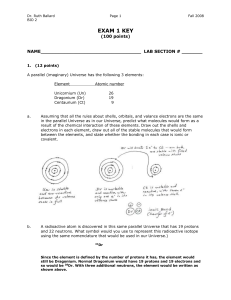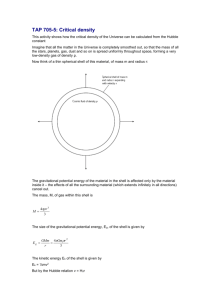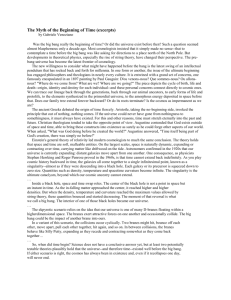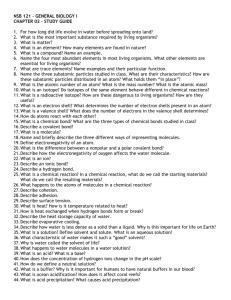Study Guide, Exam 1
advertisement
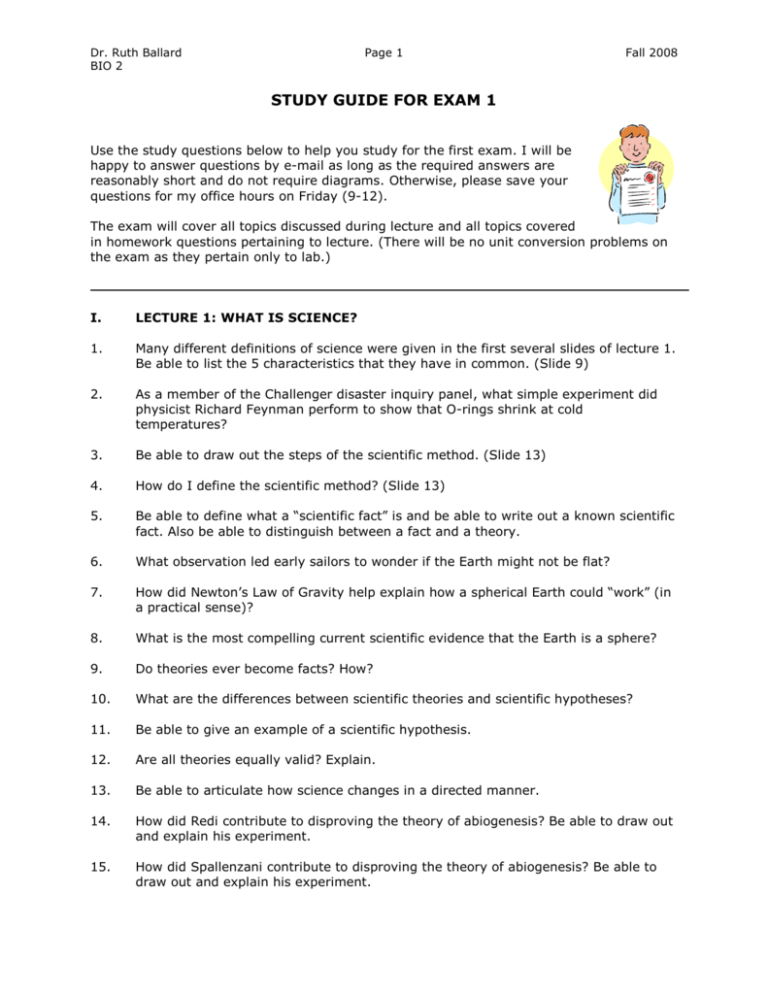
Dr. Ruth Ballard BIO 2 Page 1 Fall 2008 STUDY GUIDE FOR EXAM 1 Use the study questions below to help you study for the first exam. I will be happy to answer questions by e-mail as long as the required answers are reasonably short and do not require diagrams. Otherwise, please save your questions for my office hours on Friday (9-12). The exam will cover all topics discussed during lecture and all topics covered in homework questions pertaining to lecture. (There will be no unit conversion problems on the exam as they pertain only to lab.) I. LECTURE 1: WHAT IS SCIENCE? 1. Many different definitions of science were given in the first several slides of lecture 1. Be able to list the 5 characteristics that they have in common. (Slide 9) 2. As a member of the Challenger disaster inquiry panel, what simple experiment did physicist Richard Feynman perform to show that O-rings shrink at cold temperatures? 3. Be able to draw out the steps of the scientific method. (Slide 13) 4. How do I define the scientific method? (Slide 13) 5. Be able to define what a “scientific fact” is and be able to write out a known scientific fact. Also be able to distinguish between a fact and a theory. 6. What observation led early sailors to wonder if the Earth might not be flat? 7. How did Newton’s Law of Gravity help explain how a spherical Earth could “work” (in a practical sense)? 8. What is the most compelling current scientific evidence that the Earth is a sphere? 9. Do theories ever become facts? How? 10. What are the differences between scientific theories and scientific hypotheses? 11. Be able to give an example of a scientific hypothesis. 12. Are all theories equally valid? Explain. 13. Be able to articulate how science changes in a directed manner. 14. How did Redi contribute to disproving the theory of abiogenesis? Be able to draw out and explain his experiment. 15. How did Spallenzani contribute to disproving the theory of abiogenesis? Be able to draw out and explain his experiment. Dr. Ruth Ballard BIO 2 Page 2 Fall 2008 16. How did Pasteur contribute to disproving the theory of abiogenesis? Be able to draw out and explain his experiment. II. LECTURE 2: THE UNIVERSE AND ITS CHEMISTRY; WHAT IS LIFE? 1. Be able to list some characteristics of living things that are NOT shared by non-living things. Also be able to list some characteristics of living things that are also shared by non-living things. 2. What is the difference between digital and analog information systems and how does this relate to life’s information molecule, DNA? 3. What is entropy? Why must all living organisms fight entropy and how do they do it? 4. How does the sun enable living organisms to fight entropy? 5. Be able to draw out and explain Slides 6 and 7. 6. In class, I told a story about a man who sought out Buddha because he needed help in solving some of his problems. What did Buddha tell him? What was this man’s 84 th problem and how did Buddha help him solve it? 7. What is Dr. Suess’ magical kingdom of Solla Sollew and why can we never get there? 8. Richard Dawkins says that life is nothing more than a stream of digital information that changes over time. Why do you think he says this? 9. What four things does life need to arise from non-living matter? 10. According to the Big Bang Theory, how long ago did the Universe come into being? What exactly came into being at that time? 11. Scientists believe that space is expanding but it’s not expanding into anything. Explain! 12. What happened approximately 300,000 years after the Big Bang? 13. What 4 elements were “created” in the Big Bang? Which element (by far) was most predominant? 14. Which element is currently the most predominant in the Universe? 15. What happened approximately 600,000,000 years after the Big Bang? 16. What elements were present in the “first generation” of stars that formed after the Big Bang? Could they have had planets? If so, what kind? 17. How many stars are in a typical galaxy like our Milky Way? How far across is the Milky Way (in light years)? 18. How long does it take light to travel one light year? Dr. Ruth Ballard BIO 2 Page 3 Fall 2008 19. Why is the sun hot? 20. Is the Sun (our star) a small, medium-sized, or large star? Why is this important for the ability of life to evolve on Earth? (Can life evolve on planets around very large stars? Why or why not?) 21. How are new elements in the Universe created? (Be able to list 2 ways.) 22. Why do very massive stars explode at the end of their life cycles (supernovas)? What’s special about the element iron? 23. Could life have evolved in a Universe without supernovas? Explain. 24. What is a neutron star? A black hole? 25. How old in our solar system? 26. What is the nebular hypothesis? 27. How does the Earth’s magnetic field (caused by the spinning of its molten iron core) protect the Earth’s atmosphere? 28. Be able to list at least 4 of the gasses that were present in Earth’s early atmosphere. LECTURE 3: THE CHEMISTRY OF LIFE I: ATOMS, MOLECULES, AND BONDS 1. What is an element? How many elements naturally occur in the Universe? How many are used by life forms on Earth? 2. What is a compound? Is O2 a compound? If not, what is it? 3. What are the four most common elements (by weight) in the human body? 4. There is lots silicon (Si) on Earth but life forms don’t use this element, even though it can form 4 bonds with other molecules, just like carbon. Why is this? 5. What happens when a person has an iodine deficiency? 6. Upon what does an element’s chemical behavior and properties depend? 7. What are the three main “parts” of an atom? Where is each located? 8. Be able to define atomic number, mass number, and atomic mass. 9. What are isotopes? Are all isotopes radioactive? Be able to give examples. 10. How are radioactive isotopes used to date rocks? 11. How can radioactive isotopes be used to detect cancerous tissue in a PET scan? Dr. Ruth Ballard BIO 2 Page 4 Fall 2008 12. How could you use radioactive isotopes to determine the optimal pH for DNA polymerase (the enzyme that replicates DNA)? 13. Where does an atom store its energy? (E = mc 2) 14. What is an electron shell? Does an electron have more energy when it’s in an outer shell or an inner shell? 15. When an electron changes shells and loses energy, in what form does it release the energy? 16. What are valence electrons? 17. Given the atomic number of an element, be able to draw out its shells and the locations of the electrons in its shells. 18. Be able to predict whether an element is likely to form a bond with another element and what type of bond (covalent or ionic) it will form. 19. What is the difference between an electron shell and an electron orbital? 20. How many orbitals are in the first shell? How many are in the second shell? The third shell? 21. What is a covalent bond? What is an ionic bond? 22. What is electronegativity? How does the greater electronegativity of oxygen over hydrogen affect the behavior of water molecules? 23. What is a hydrogen bond? Is this type of bond strong or weak? LECTURE 4: THE CHEMISTRY OF LIFE II: WATER AND CARBON 1. What percent of a living organism is comprised of water? 2. Why is water fluid? 3. What are the four properties of water that are fundamental for life? 4. How do land plants use water’s cohesive property? How do insects use it? 5. What is specific heat? Does water have a high or low specific heat? 6. How does the ability of water to moderate temperature help explain the cyclical nature of the ice ages? 7. Why does water expand upon freezing? How does this property of water protect life forms that live in bodies of water? 8. At what temperature is water maximally dense? Dr. Ruth Ballard BIO 2 Page 5 Fall 2008 9. What is a hydration shell? About what types of molecules does a hydration shell form? 10. Be able to define the terms hydrophilic and hydrophobic. Is oil hydrophilic or hydrophobic? What about table salt? 11. Be able to calculate the hydrogen ion concentration in an aqueous solution at a particular pH. Also be able to calculate the pH of a solution with a particular molar concentration of H+ or OH- ions. 12. In pure water, about how many molecules are broken apart into hydronium and OHions at any given time? 13. Be able to define the terms acid and base. 14. What is a buffer solution and how does it work? 15. What is “organic chemistry?” 16. What is vitalism? What is mechanism? Which theory does scientific evidence support? 17. Be able to predict whether an organic molecule will have a tetrahedral or flat shape. 18. Why is carbon able to from so many bonds with so many different types of elements? 19. What are isomers? What are the three types of isomers? 20. What evidence from isomers suggests that all living things on Earth evolved from a common ancestor? 21. Be able to list the 7 important functional groups. Also know the chemical properties conferred on a molecule by these functional groups. (Spend a lot of time studying Slides 55-56). LECTURE 5: THE CHEMISTRY OF LIFE III: BIOMOLECULES 1. What are the 4 classes of life’s large biomolecules? Which of these are polymers? 2. What is a polymer? What is a condensation reaction? What is hydrolysis? 3. What are polymers of sugar called? 4. What is a monosaccharide? What is the most common monosaccharide and what is its chemical formula? 5. What is a disaccharide? Be able to give an example. 6. Is the following molecule a carbohydrate? How do you know? C18H34O2 Dr. Ruth Ballard BIO 2 Page 6 Fall 2008 7. Which of the following functional groups do sugars contain? Hydroxyl, carbonyl, carboxyl, amino, sulfhydrl, phosphate, methyl? 8. What is the difference between ketose and aldose sugars?
